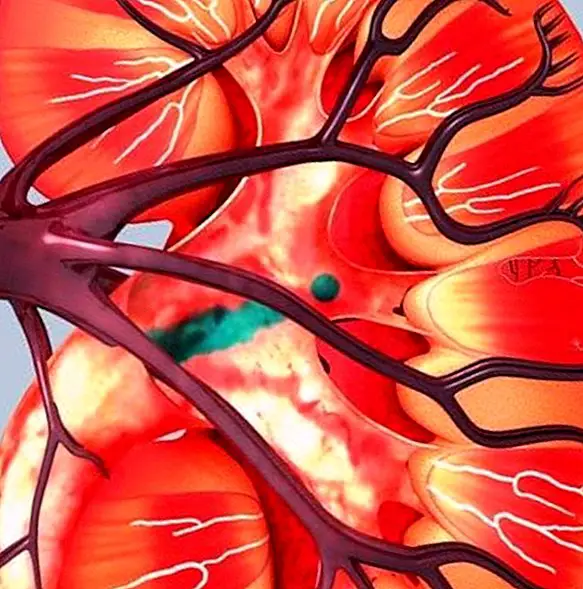Breast cancer: what it is, causes and symptoms of alarm
The breast cancer -commonly called breast cancer-, it is something that affects several women in the world; it is a disease that should not be taken lightly and with which all possible measures should be met to avoid it and treat it.
In this article we will talk about breast cancer, the warning signs that you should take into account when there is the possibility of suffering from it, its causes and the treatment as a procedure that is carried out for this condition.

What is breast cancer?
Breast cancer is a malignant proliferation given in the epithelial cells lining the breast ducts or lobules.
It is a clonal disease, where a single cell product of a series of somatic or germline mutations acquires the ability to divide without control or order, as in all types of cancer, causing it to reproduce to form a tumor.
The resulting tumor, which begins as a mild anomaly, becomes severe, invades neighboring tissues and eventually spreads to other parts of the body.
Risk factors that can predispose us to suffer from breast cancer
- Family history of breast cancer.
- The age that the woman is going through, being the most dangerous age group between 40 and 50 years old and in the menopause stage.
- Having suffered another type of cancer
- Obesity, sedentary lifestyle.
- Inadequate food
- Abuse of alcohol and tobacco consumption.
- Oral contraceptives
- Hormone treatments
- Reproductive treatments with estrogens and endogenous.
- Not having breastfed the children also predisposes the woman to be able to suffer from breast cancer.
What are the most obvious symptoms of breast cancer?
There are a series of symptom or of alarm signs that can alert the woman about the possible presence of a tumor in the breasts or breasts. Although we must bear in mind that in many occasions the presence of a lump is due to the presence of cysts and other benign lumps. In any case, it is always important to go to the doctor for a more specific examination.
The most important sign is the presence of a protuberance or mass, especially that it is not painful, hard and has irregular edges. However, tenderness-sensitive, rounded and soft tumors may also arise, even with pain.
Other signs may also occur, such as swelling of part or all of the breast, pain in the nipple or breast, retraction of the nipples, redness or thickening of the skin of the nipple or breast, nipple discharge and irritation and cracks in the skin.

As we indicated, any of these signs can be caused by other conditions that have nothing to do with breast cancer. So, If any symptom is essential, notify your doctor.
Types of breast cancer
There are two main types of breast cancer, and these are:
- Infiltrating ductal carcinomaIt begins in the tubes that carry milk from the breast to the nipple of the woman. This is the most frequent, being even the one given in 80% of the cases.
- Infiltrating lobular carcinoma: begins in parts of the breast called lobules, which produce breast milk. This is the second most frequent, and it represents 12% of cases of breast cancer.
Factors that increase the risk of getting breast cancer
There are certain factors that increase the risk of contracting this disease. Next they will be specified in the following list:
- Advanced age.
- Having had the first menstruation at an early age.
- Old age at the time of the first birth or never having given birth.
- Family history of breast cancer.
- Consume hormones such as estrogen and progesterone.
- To consume in excess alcohol.
- Being white is also a risk factor under the latent condition of breast cancer.
How to correctly diagnose breast cancer
- The breast examination should be performed in an upright position, sitting and lying down with the woman's hands behind the head.
- Breasts should be inspected for differences in size, skin or nipple retraction, prominent vein patterns, and signs of inflammation.
- The flat surface of the tip of the fingers should be used to feel the breast tissue against the chest wall.
- The axillary and supraclavicular areas should be checked for nodules.
- The nipple should be gently compressed to check for secretions.
The use of mammograms and ultrasounds is also very useful for the evaluation and development of breast cancer diagnoses.

Even in many cases and through these evaluations can be detected at a time when the cancer is not highly evolved and it is possible to treat it without many disadvantages.It is recommended to have a medical check-up once a year.
Treatment
The treatment of this cancer can be of different forms depending on its character and holistic classification, these are:
Through surgery, where depending on the size of the tumor and ganglionic commitment, the necessary surgical procedures are performed, these being:
- Lumpectomy or lumpectomy: involves the removal of the tumor mass with an adequate margin of tissue.
- Quadrantectomy: involves the removal of a breast quadrant with the tumor; it can be accompanied by ganglionic emptying, that is, by the removal of axillary lymph nodes.
- Simple mastectomy: involves the removal of the breast with the tumor, including the nipple, areola, and skin, as well as one or more axillary lymph nodes. None of the muscles below the chest are removed. It can be hygienic in advanced tumors for palliative purposes.
- Modified radical mastectomy: resection of the breast with axillary dissection. A negative pressure drainage system is left.
In addition to treatment by surgery, there are other types of treatment, which are:
- Drugs or chemotherapy intravenously or orally or chemotherapy intrathecally.
- Radiotherapy
- Biological therapy
- Adjuvant therapy
- Integrative therapies
- Hormonotherapy
- Medications to prevent and treat nausea and other side effects of treatment.
New discovery: consuming too much sugar increases the risk of breast cancer
We know that cancer and nutrition are intimately linked. Scientists talk about the protective role of fruits and vegetables. But, a new study indicates the ominous relationship with a diet too rich in sugars. The problem is that the risk of breast cancer It is not negligible.
The study was conducted on a sample of more than 93,000 women, for the Women's Health Initiative survey. The results attest to the close relationship between high insulin rates and the real risk of suffering from breast cancer. The insulin It is a hormone secreted to regulate the blood sugar rate.
Scientists have shown the correlation that occurs between obesity and the increase in breast cancer. But, they have shown that most of it can be explained by the increase in glycerin and hormonal factors. According to the doctors, this would be the main risk factor.
For Dr. David Servan-Schreiber, author of the bookAnticancer, this study confirms "the role of eating too rich in sugars, with the appearance of certain cancers, and again emphasizes the need to communicate to patients affected by cancer, the importance of adopting a diet with a low glycemic index , to reduce the segregation of insulin and its negative influence on the growth of cancer cells ".
A balanced diet It is essential to maintain good health. This article is published for informational purposes only. It can not and should not replace the consultation with a Physician. We advise you to consult your Trusted Doctor. ThemesCancer



